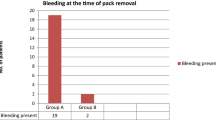Abstract
Endoscopic septoplasty has become the favored approach for the treatment of a deviated septum. Careful septal dissection results in less bleeding, clear endoscopic view, shortened operative time, and fewer postoperative complications. We describe our 5-year experience of using an 8 French Frazier suction tube for submucosal dissection compared with the traditional septoplasty. A total of 434 patients who underwent septoplasty were recruited. The patients in the study were divided into two Groups 1 and 2 based on the employed surgical techniques to treat deviated nasal septum: traditional septoplasty (Group 1: 105 patients) and suction-tube-assisted endoscopic septoplasty (Group 2: 329 patients). All the patients were followed up for a minimum of 6 months. No statistically significant differences could be traced between the groups in any demographic factor, regarding the gender, age, and the intraoperative and postoperative complications. A significantly shorter operative time was found in Group 2 (P < 0.001). The overall incidence of minor complications was 6.6% in Group 1 and 4.6% in Group 2. The suction-tube-assisted dissection technique is found to be a surgical alternative, effective with a significantly shorter operating time, and economical option in septal surgery.



Similar content being viewed by others
References
Hwang PH, McLaughlin RB, Lanza DC, Kennedy DW (1999) Endoscopic septoplasty: indications, technique, and results. Otolaryngol Head Neck Surg 120:678–682
Chung BJ, Batra PS, Citardi MJ, Lanza DC (2007) Endoscopic septoplasty: revisitation of the technique, indications, and outcomes. Am J Rhinol 21:307–311
de Ru JA (2015) Septoplasty is a proven and effective procedure: an expert’s view of a burning issue. B-ENT 11:257–262
Getz AE, Hwang PH (2008) Endoscopic septoplasty. Curr Opin Otolaryngol Head Neck Surg 16:26–31
Kang N, Youn A, Oh SH (2008) Septal harvesting instruments in rhinoplasty. Aesthet Plast Surg 32:549–551
Ketcham AS, Han JK (2010) Complications and management of septoplasty. Otolaryngol Clin North Am 43:897–904
Yanagisawa E, Joe J (1997) Endoscopic septoplasty. Ear Nose Throat J 76:622–623
Sathyaki DC, Geetha C, Munishwara GB, Mohan M, Manjuanth K (2014) A comparative study of endoscopic septoplasty versus conventional septoplasty. Indian J Otolaryngol Head Neck Surg 66:155–161
Certal V, Silva H, Santos T, Correia A, Carvalho C (2012) Trans-septal suturing technique in septoplasty: a systematic review and meta-analysis. Rhinology 50:236–245
Cantrell H (1997) Limited septoplasty for endoscopic sinus surgery. Otolaryngol Head Neck Surg 116:274–277
Schwab JA, Pirsig W (1997) Complications of septal surgery. Facial Plast Surg 13:3–14
Muhammad IA, Nabil-ur R (2003) Complications of the surgery for deviated nasal septum. J Coll Physicians Surg Pak 13:565–568
Topal O, Celik SB, Erbek S, Erbek SS (2011) Risk of nasal septal perforation following septoplasty in patients with allergic rhinitis. Eur Arch Otorhinolaryngol 268:231–233
De Sousa Fontes A, Sandrea Jimenez M, Chacaltana Ayerve RR (2013) Endoscopic septoplasty in primary cases using electromechanical instruments: surgical technique, efficacy and results. Acta Otorrinolaringol Esp 64:317–322
Sousa A, Iniciarte L, Levine H (2005) Powered endoscopic nasal septal surgery. Acta Med Port 18:249–255
Acknowledgements
None.
Author information
Authors and Affiliations
Corresponding author
Ethics declarations
Funding
This work was supported in part by grants from the Research Fund of Tri-Service General Hospital (TSGH-C104-015, TSGH-C104-041, and TSGH-C105-038), Taipei, Taiwan.
Conflict of interest
The authors declare no conflicts of interest.
Ethical approval
All procedures performed in studies involving human participants were in accordance with the ethical standards of the institutional and/or national research committee and with the 1964 Helsinki declaration and its later amendments or comparable ethical standards. For this type of study, formal consent is not required.
Rights and permissions
About this article
Cite this article
Lai, WS., Lin, YY., Shih, CP. et al. Clinical application of suction-tube-assisted septal submucosal dissection for endoscopic septoplasty. Eur Arch Otorhinolaryngol 274, 1471–1475 (2017). https://doi.org/10.1007/s00405-016-4368-8
Received:
Accepted:
Published:
Issue Date:
DOI: https://doi.org/10.1007/s00405-016-4368-8



